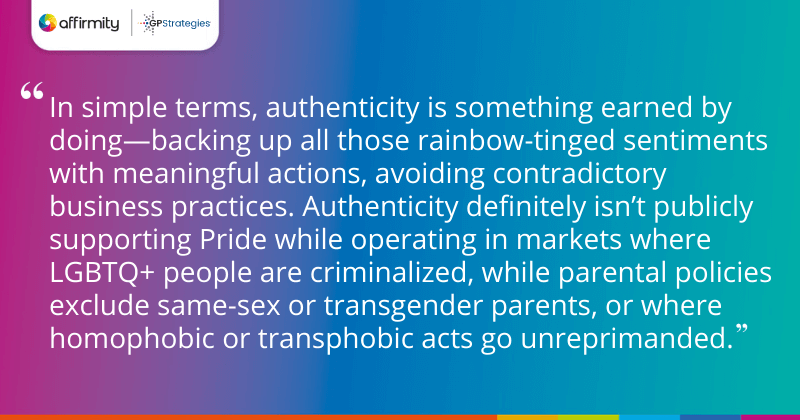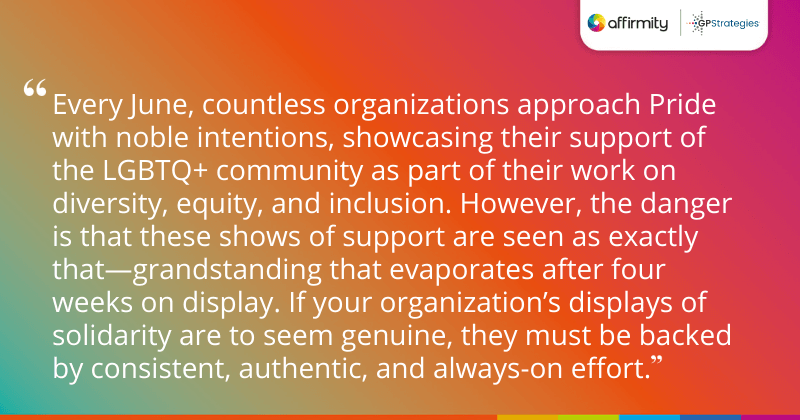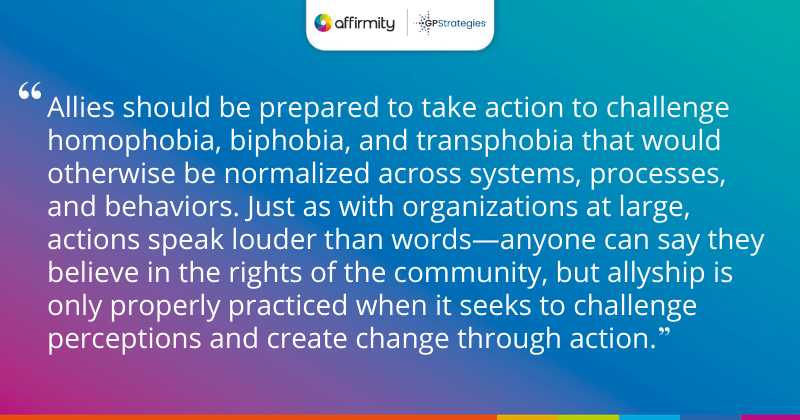Pride Month is here—an explosion of rainbows around your business, from Zoom backgrounds and notice boards, to email signatures and social media profile pictures. But when all of this Pride paraphernalia departs on July 1st, what will be left for your LGBTQ+ employees and customers? Alasdair James Scott, Senior Inclusion & Diversity Consultant at PDT Global (part of Affirmity) examines why Pride is a movement, not a moment.
Pride continues to be a time for many LGBTQ+ people to be unapologetically themselves, to celebrate who they are, and laud the crucial steps toward equality that have already been made. However, its roots in protest and the continuing need to stand against historical wrongs and ongoing injustices (including recent “Don’t Say Gay” and transgender-hostile bathroom bills) create a tension that isn’t lost on those enjoying all the revelry. This friction between celebration and protest complicates your organization’s participation in proceedings.
Every June, countless organizations approach Pride with noble intentions, showcasing their support of the LGBTQ+ community as part of their work on diversity, equity, and inclusion. However, the danger is that these shows of support are seen as exactly that—grandstanding that evaporates after four weeks on display. If your organization’s displays of solidarity are to seem genuine, they must be backed by consistent, authentic, and always-on effort.
Here are three things to consider.
1) How Can Organizations Like Ours Authentically Support the LGBTQ+ Community?

What does authenticity even look like? Well, there’s certainly an element of futility in trying to learn how to appear genuine in any domain. In simple terms, authenticity is something earned by doing—backing up all those rainbow-tinged sentiments with meaningful actions, avoiding contradictory business practices. Authenticity definitely isn’t publicly supporting Pride while operating in markets where LGBTQ+ people are criminalized, while parental policies exclude same-sex or transgender parents, or where homophobic or transphobic acts go unreprimanded.
In this way, authentic support is rather simple: you just need a common thread running between the events you do during Pride Month and the work you deliver during the rest of the year. An organization could ask itself critical questions such as:
- Given your progress on LGBTQ+ issues in the last year, can your Pride events be justified?
- If challenged, can you demonstrate the solid foundations of support you have built for your LGBTQ+ colleagues?
- How transparent are you about your ongoing initiatives to support the LGBTQ+ community?
LEARN ABOUT THE ROLE OF ERGs IN ONGOING SUPPORT | ‘5 Things Your Resource Groups Need In Order to Truly Drive Inclusion’

2) What Does Year-Round LGBTQ+ Support Look Like?
Answering the questions above will help you begin to understand how deep your support of the community actually goes and whether your Pride efforts are viable. There are many practical things organizations can do year-round to work towards this viability. Here are just a few to start:
- Have an LGBTQ+ specific anti-discrimination policy. This should be designed around the specific challenges that the community faces in the workplace.
- Operate D&I training programs on key topics such as inclusive language, personal pronouns, effective allyship, and the various identities within the LGBTQ+ acronym.
- Investigate and implement the overhauls required for your policies to account for the LGBTQ+ community’s needs. Consider healthcare, mental health, parenting, and wellness, among others.
- Host quarterly “listening circles” in which LGBTQ+ colleagues can share moments of celebration and identify opportunities for improvement (and act on those opportunities).
- Observe key dates outside of Pride Month—such as International Transgender Day of Visibility and International Day Against Homophobia, Transphobia, and Biphobia.
LEARN MORE ABOUT FOSTERING AN ONGOING DE&I PROCESS | ‘Driving DE&I: Where to Begin and How to Impact Real Change [Q&A]’
3) What Is Required of Individual LGBTQ+ Allies?

Organizations are increasingly embracing LGBTQ+ allyship as a visible counter to today’s climate. Cisgender and straight allies in the workplace can be an important piece of the puzzle: they can champion the cause by creating safe moments for listening and conversation, by standing up for marginalized colleagues, and just generally being engaged with the key issues.
Allies should be prepared to take action to challenge homophobia, biphobia, and transphobia that would otherwise be normalized across systems, processes, and behaviors. Just as with organizations at large, actions speak louder than words—anyone can say they believe in the rights of the community, but allyship is only properly practiced when it seeks to challenge perceptions and create change through action.
Expectations are high. Allies need to be dedicated, educated on key issues, humble when listening to lived experience, and ready to stand up and stand aside when required.
YOU MAY ALSO FIND USEFUL | ‘The Undeniable Value of Inclusive Leadership and Visible Equity’
Why All This Work Is Worth It!
None of the work towards change described above is easy, but it is vital. Your LGBTQ+ staff and the wider community will feel it’s more than worth the effort, and it will help lay the groundwork for better retention of those people as part of your efforts towards inclusion. So as the celebrations continue, remember that Pride is just the tip of the iceberg—a showcase for your interventions on behalf of LGBTQ+ people all year round.
Remember: be authentic, be consistent, be transparent, and be proud of your people.
Build a better working environment for all of your employees with our employee resource group (ERG) platform and digital inclusion training.
A version of this article previously appeared on c-levelmagazine.com
